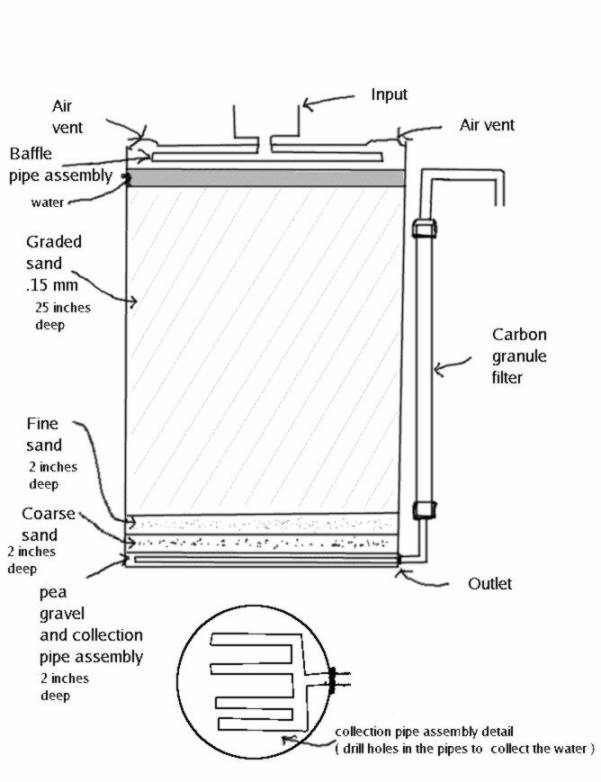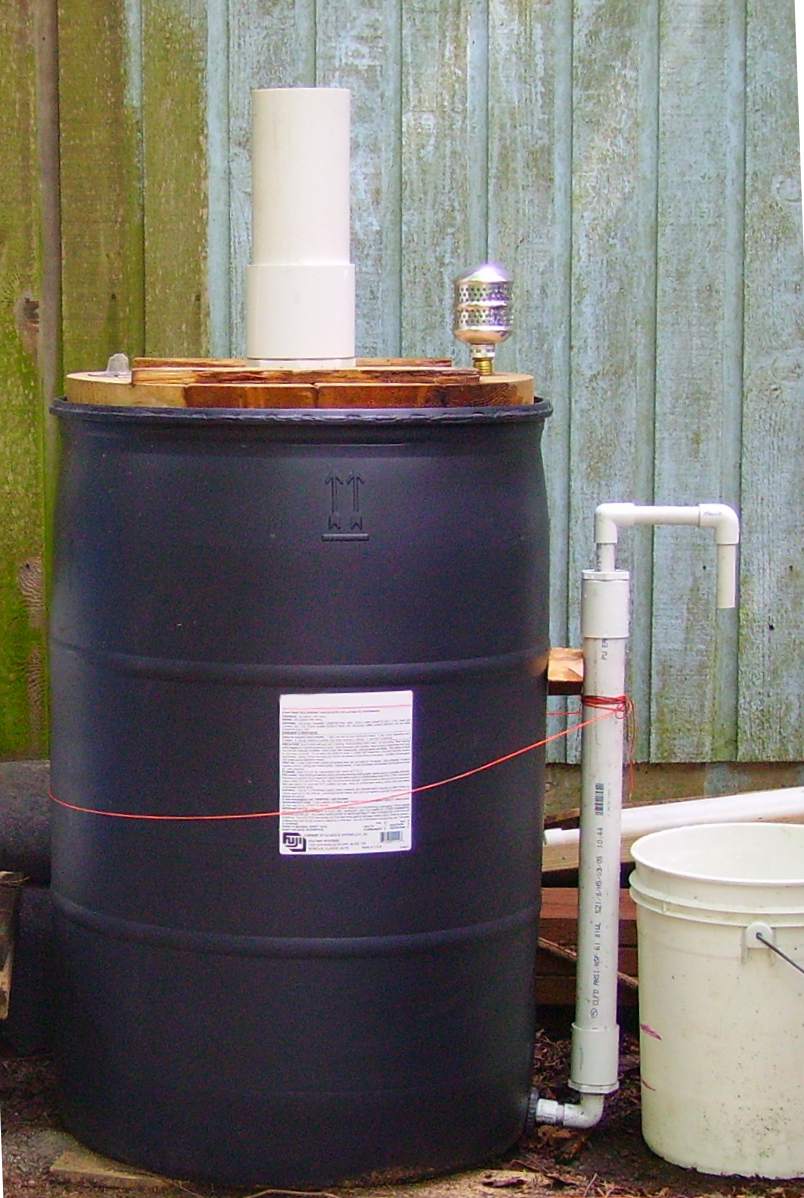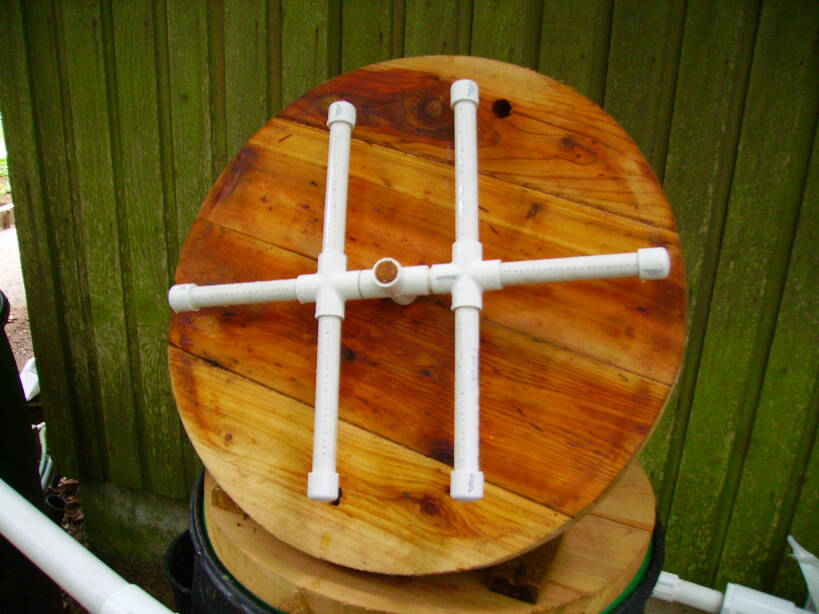Comment filtrer l’eau avec un filtre à sable
Soutenez le travail d’Howtopedia, aidez-nous à continuer à écrire et à traduire plus d'articles pratiques sur des technologies simples!
<paypal />
Sommaire
Description brève
- Problème: filtrer l'eau
- Idée: utiliser les propriétés de filtrage de sable
- Difficulté: comprendre le principe du "schmutzdecke". utilisation correcte du filtre (première utilisation, filtrage continu, remplacement régulier du sable)
- Game de prix: bon marché
- Matériel nécessaire: un grand récipient (surfaces non réactifs de préférence: plastique, réservoirs en béton... à partir de 200 litres et plus), différentes tailles de sable, réservoirs et tuyaux pour l'eau sale et de l'eau propre, un robinet
- Zone géographique: globale
- Compétences: les simples compétences d'un plombier
- Combien de personne? à partir d'une personne
- Combien de temps? 1 à 4 jours pour construire le filtre, en fonction de sa complexité, 10 jours avant que l'eau puisse être consommée.
Description
Filtres à sable à gravité lente
Avec ce type de filtres à sable, l'eau potable peut être accessible. Grâce à l'action mécanique et biologique de la couche de sable, filtres à sable à gravité lente suppriment les bactéries ainsi que les petites particules contenues dans l'eau. Ainsi, l’eau devient potable. Ceci est une introduction de base à l'objet et devrait aider à maintenir un approvisionnement constant en eau courante propre en utilisant une technologie simple. Le filtre à sable décrit ci dessous est conçu pour un usage domestique.
Source d'eau
Il est important d'avoir une source d'eau relativement propre, ce qui signifie exempt de produits chimiques et de métaux lourds, étant donné qu’un filtre à sable ne pourra pas filtrer suffisant l’eau chimiquement polluée pour la transformer en eau potable. Il est important de tester un échantillon d'eau dans un laboratoire avant de commencer. Même l'eau de source ou l’eau très claire de la rivière devrait être testée. Si votre eau de source a un niveau élevé de contamination, essayez d’en trouver une autre. Si cela n'est pas possible, d'autres modes de filtration doit être utilisés. Si l'eau est très brune, c’est-à-dire qu’elle a un niveau de turbidité élevé, elle doit être traitée avant d’être filtrée par le sable. Par exemple, elle peut rester dans le décanteur ou passer à travers un filtre d'ébauche horizontal avant qu'elle ne passe dans le filtre à sable approprié.
Fonctionnement du filtre
L'eau passe à travers le sable de haut en bas. Les grandes particules en suspension se déposent dans les couches supérieures du sable. Les petites particules de sédiments organiques restées dans le filtre à sable sont consommées par des organismes microscopiques, y compris les bactéries et les protozoaires qui «collent» dans les couches de boue qui se forment autour des particules de sable. L'eau propre qui passe à travers le filtre est propre à la consommation. Si la taille des grains est de l'ordre de 0,1 mm de diamètre, un filtre à sable peut supprimer tous les coliformes fécaux (bactéries qui proviennent de matières fécales) et pratiquement tous les virus.
Filtres à sable lents
Le dessin montre un filtre à sable classique. L'eau sale doit s'écouler dans la partie supérieure de la cuve sans perturber le schmutzdecke (couche de boue qui se forme sur le dessus du sable au bout de quelques jours et contient des bactéries bénéfiques). Il devrait y avoir une profondeur d'eau suffisante au-dessus du sable afin que suffisamment de pression pousse l'eau sale à travers le film biologique , le lit filtrant et dans le gravier de support. Cette profondeur devrait idéalement être d'environ 2-3 mètres (7-10 pieds), même si 1,5 mètres (4 pieds) devraient également permettre au filtre de fonctionner correctement. Cette profondeur dépend des propriétés du sable et de la porosité du film biologique. Le niveau maximum de l'eau peut être contrôlé en utilisant un flotteur et une vanne de commande ou par le maintien du levier de l'eau près de la ligne de débordement. Important: la filtration doit être continue, le sable doit toujours être submergé et le film biologique protégé des rayons du soleil et de fortes différences de température.
La profondeur de sable (lit filtrant ) a une forte influence sur l'efficacité de la filtration et doit être au moins (minimum) 75 cm / 1 m (30 " - 40") .
Les propriétés du sable sont définies avec le diamètre des grains et les propriétés ES (taille effective) et UC (coefficient d'uniformité ). Pour le filtre à sable lent, le sable doit être très fin ( 0,1 à 0,35 mm de diamètre ) ES est typiquement 12 à 40 mm (0,5 " à 1,6 " ) et l'UC doit être inférieur à environ 2,5.
Les taux typiques de traitement de l'eau dans les filtres à sable lents sont environ 2,5 m3 / [m2 de filtre coupe zone - jour] = environ 0,1 m / heure (0,33 m / h). Le taux de filtration peut être déterminé par un débitmètre sur le robinet de sortie. Sauf si l'eau brute est particulièrement bien traitée à environ 20 unités de turbidité, ce chiffre devrait être maintenu, sauf si une désinfection post-ssf très fiable est en place. Une turbidité élevée de l'eau (beaucoup de particules dans l'eau) brute va bloquer le filtre à sable rapide, raccourcir le temps entre les nettoyages et l'abaissement de la qualité de l'eau. Il peut aussi raccourcir la durée de vie du filtre extrêmement de plusieurs mois à quelques jours. L'eau brute devrait être pré-traitée, par exemple avec un filtre horizontal d'ébauche qui permet de réduire la turbidité d'une moyenne d'environ 200 unités, avec des pics occasionnels à court terme à environ 1000, à environ 20.
La réduction de la turbidité peut également se produire grâce à des étangs ou des bassins de sédimentation avec de l'eau flottante. Le film biologique est une couche où les processus bactériologiques et physiques se produisent, la principale étant que la plupart des matières en suspension est enfoncée dans une couche fine et dense dans lequel les pores peut être inférieure à un micron. L'épaisseur de cette couche augmente avec le temps jusqu'à ce que les débits deviennent très petites, à ce stade, il est habituellement d'environ 25 mm (1 "). C'est le moment où une couche du filtre doit être enlevée.
Les bactéries et les virus sont piégés dans le film biologique (schmutzdecke). L'activité bactérienne et biologique maximise dans le film biologique mais continuera jusqu'à 20 cm de profondeur dans le lit du filtre à sable. Un certain niveau minimum d'oxygène dissous doit être présent pour soutenir les actions aérobies qui se produisent dans le lit. Après l'installation initiale du filtre à sable, la formation du schmutzdecke et l'activité bactérienne / biologique prendra quelques jours ou quelques semaines en fonction de la température ambiante. Pendant cette période, l'eau traitée est impropre à la consommation humaine et ne doit pas être bue ou alors elle doit être filtrée dans un autre filtre ou être désinfectée avec d'autres moyens. Les tests de qualité de l'eau doivent être effectués à intervalles réguliers jusqu'à ce qu'un niveau requis soit atteint.
Cleaning the filter
When clean water flow becomes very small, the sand filter must be cleaned. Remove very carefully about 25 mm (1") of the top layer, which includes most of the existing schmutzdecke, with broad flat-bottomed shovels after dropping the water level to slightly below the latter. In strong hot sunlight this should be done as quickly as possible to avoid drying out and damage to the biological matter in the top layer, which will be the base of the new schmutzdecke. When the filter is restarted, the processed water must again not be consumed until the required level of quality is again reached. This takes several days.
When the depth of the bed of sand will have been reduced by the cleaning processes to about 0.75 meters (30"), the original depth must restored by adding new sand. because the new sand will have no biological activity, the process is accelerated by removing and discarding the schmutzdecke, and then the top 20 centimeters of the existing bed is removed and kept to be re-use on top of the new sand. this help to restore quickly the biological activity and new schmutzdecke. The sand from the existing bed should not be allowed to dry out and should be set in place again as quickly as possible.
Difficulties
- When used for a large amount of water, the Slow Sand Filter needs large amounts of land, because of the low filtering rates ( 10 per cent of the filtering rates allowed by rapid filtration).
- Because of the slow rates, the clean water has to be stored in proper containers (clean and protected from light to avoid Algae proliferation and from dust) to adapt the peak demand.
- Great care in the operation and maintenance, in particular in relation to the schmutzdecke which requires some time to form. The processed water cannot be considered safe until it has and the water that is passed through the system while the schmutzdecke is forming must be cycled back or discarded.
- While first building the filter,in order to avoid the formation of air pockets in the sand bed, the sand should be either dropped in the tank filled up with water or be filled with water from the bottom.
- In regions with high arsenic concentration in the ground water, special measures apply! the incoming water should be oxigenated (cascade or sprinkler principle) when poured in the filter, and regulary completely drained out of the filter container to stop bacterial activity! for a better arsenic removal, the additition of a top bed of iron nails might be necessary, especially if the water has a low iron concentration.
See: http://www.arsenic.eawag.ch
Ngai, T.; Walewijk, S. (2003) The Arsenic Biosand Filter (ABF) project: design of an appropriate household drinking water filter for rural Nepal. Final Report. Massachusetts Institute of Technology and Stanford University, USA.
Success Story
We have built one of these biological layer sand filters from mostly recycled material, run it for 3 weeks and had the water tested. (The website link below in the "links" section has the details of the tests and more; and the "plans illustrations and posters" sections has some pictures) The filter removed 100 percent of the E.Coli, Coliform and Fecal Coliform bacteria from the water. These filters work. And they work well. This system produces no left over plastic bottles, and for the price you would pay for four or five cases of "top quality" bottled water, you can probably build this entire filter. If you buy bottled water year round you could easily pay for the battery, pump, storage barrels and filter for less than it would cost you for the bottled water. Then all your water is free. But you don't even need the pump or battery. If you are living in one of the many areas in the U.S. that are now experiencing 50 or 100 year droughts you may want to consider this seriously . . . build it and have it ready for the first rain, and you will have all the water you need to drink, or water your flowers or wash your car . . . what ever - it's your water. Just remember that the water must be circulated through the filter for at least 3 weeks before it is safe to drink. And, any chemicals you have put on your roof will be in the water you collect. (those chemicals will eventually end up in water anyway because they flow off your roof into the ground and eventually back into a river or aquifer.) An 1800 square foot roof will collect over 2200 gallons of water with 2 inches of rainfall. If you have 6 downspouts equally spaced that means each one will deliver over 300 gallons of water. You don't need a college degree to be smart enough to figure out how to be careful and how to operate one of these filters. The basic operation is simple. The God given ecosphere of this earth cleans water for us with natural processes that work in these filters much in much the same way our rapidly disappearing wetlands clean water for us. The biofilm that grows on the sand forms a living barrier that destroys most bacteria and only allows water to pass through it. These filters (much larger of course) are used in Europe extensively for public water supplies.
Caution: know exactly what is in the sand used in the filter. Sand can contain many different kinds of contaminants, some very hazardous.
Plans, Illustrations, Posters

This is a drawing of the filter

This is a picture of the outside details

This is a picture of the baffle pipes that keep the incoming water from disturbing the biolayer on top of the sand inside.

Detail of the baffle pipes

The added convenience of a recirculation system.
Contacts
Links
- "Success story" link to the website describing the filter in detail:http://www.shared-source-initiative.com/biosand_filter/biosand.html
- Harvesting rainwater and BioSand filters:http://www.rainwaterconnection.com
- Brief description and drawing of a BioSand filter:http://www.unc.edu/sobseylab/res.html
- Filters are used in many parts of the world:http://www.villagehealthproject.org/6.html
- Drawings and explanations:http://www.chrisrolling.com/cwfh.htm
- Manufacturer of filters:http://www.watertiger.net
- Nice explanation and drawing in English and other languages:http://www.jalmandir.com/filtration/biosand/biosand-filters.html
- Very detailed explanations are here at this site:http://www.biosandfilter.org/biosandfilter/
- Commercial site and one of the first developers of the BioSand filter:http://www.abheritage.ca/abinvents/inventions/inv_hw_biosand_water_filter.htm
- Pictures and explanations here:http://homepage.ntlworld.com/c.wrightson/bio_sand_filter.htm
- this link has information about the size of sand grains: (.15 - .35 mm):http://www.oasisdesign.net/water/treatment/slowsandfilter.htm
- Good explanation of filters from this site in Canada:http://www.agr.gc.ca/pfra/water/slowsnd_e.htm
- http://www.watertechonline.com/article.asp?IndexID=5210904
- http://www.waterinfo.com/ssf.htm
- Procedure for measuring turbidity: http://www.photometer.com/en/abc/abc_095.htm
Bibliography
The Davnor BioSand Water Filter
Manual of Design for Slow Sand Filtration
Slow Sand Filtration, Huisman L. and Wood, W.E., WHO 1974
"Houshold Sand Filter for Arsenic Removal, an option to mitigate arsenic from iron-rich groundwater"
Techical report, EAWAG, S.Luzi, M.Berg, P.T.K.Trang, P.H.Viet, R.Schertenleib, Hanoi, 2004
www.arsenic.eawag.ch
Ngai, T.; Walewijk, S. (2003) "The Arsenic Biosand Filter (ABF) project: design of an appropriate household drinking water filter for rural Nepal. Final Report." Massachusetts Institute of Technology and Stanford University, USA.
Related articles
- turbidity
- How to Lower Water Turbidity with a Roughing Filter,
- How to Pasteurize Water with a Plastic Bottle
- How to Build an Underground Brick Dome Water Tank
- How to Build a Rainwater Tank: Sri Lankan Pumpkin Tank
- How to Harvest Rainwater
- How to Harvest Water
- How to Stock Water in Cement Water Jars
- How to Harvest Rainwater
- How to Harvest Run Off Rainwater
Support the work of howtopedia, help us to continue to write and translate more practical articles on simple technologies!
<paypal />
Catégories
- Ebauche
- Community
- Construction
- Crisis Management
- Education
- Equipment Design
- Health
- Hygiene
- Ideas
- Pollution
- Prevention
- Products
- Recycling
- Resource Management
- Sanitation
- Small Business
- Run-Off
- Water
- Water harvesting
- Water purification
- Easy to Medium
- Global Technology
- Arid Climate
- Forest Environment
- Global
- Mediterranean Climate
- Monsoon Climate
- Montaneous Environment
- Coastal Area
- Lakes and Rivers
- Rural Environment
- Temperate Climate
- Tropical Climate
- Urban Environment
- Plastic container
- Sand
- One Person and more
- Household
- Village
- Neighbourhood
- Application
- Practical Action Spanish
- Requested translation to French
- Requested translation to Arabic
- Requested translation to Bangla
- Requested translation to Javanese
- Requested translation to Madarin
- Requested translation to Russian
- Requested translation to Swahili
- Requested translation to Tamil